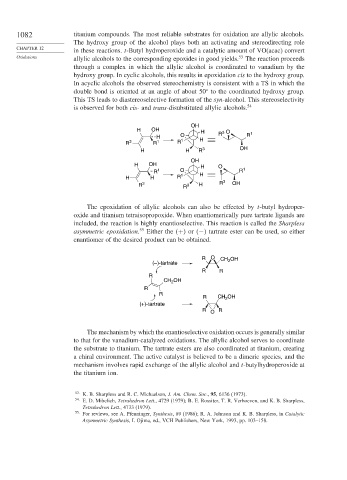Page 1106 - Advanced Organic Chemistry Part B - Reactions & Synthesis
P. 1106
1082 titanium compounds. The most reliable substrates for oxidation are allylic alcohols.
The hydroxy group of the alcohol plays both an activating and stereodirecting role
CHAPTER 12
in these reactions. t-Butyl hydroperoxide and a catalytic amount of VO(acac) convert
53
Oxidations allylic alcohols to the corresponding epoxides in good yields. The reaction proceeds
through a complex in which the allylic alcohol is coordinated to vanadium by the
hydroxy group. In cyclic alcohols, this results in epoxidation cis to the hydroxy group.
In acyclic alcohols the observed stereochemistry is consistent with a TS in which the
double bond is oriented at an angle of about 50 to the coordinated hydroxy group.
This TS leads to diastereoselective formation of the syn-alcohol. This stereoselectivity
is observed for both cis- and trans-disubstituted allylic alcohols. 54
OH
H OH H R 3 O 1
H O H R
R 3 R 1 R 1
H H R 3 OH
OH
H OH H O
R 1 O R 1
H H R 1 H
R 3 R 3 H R 3 OH
The epoxidation of allylic alcohols can also be effected by t-butyl hydroper-
oxide and titanium tetraisopropoxide. When enantiomerically pure tartrate ligands are
included, the reaction is highly enantioselective. This reaction is called the Sharpless
asymmetric epoxidation. 55 Either the + or − tartrate ester can be used, so either
enantiomer of the desired product can be obtained.
R O CH 2 OH
(–)-tartrate
R R
R
OH
CH 2
R
R
R CH 2 OH
(+)-tartrate
R O R
The mechanism by which the enantioselective oxidation occurs is generally similar
to that for the vanadium-catalyzed oxidations. The allylic alcohol serves to coordinate
the substrate to titanium. The tartrate esters are also coordinated at titanium, creating
a chiral environment. The active catalyst is believed to be a dimeric species, and the
mechanism involves rapid exchange of the allylic alcohol and t-butylhydroperoxide at
the titanium ion.
53 K. B. Sharpless and R. C. Michaelson, J. Am. Chem. Soc., 95, 6136 (1973).
54 E. D. Mihelich, Tetrahedron Lett., 4729 (1979); B. E. Rossiter, T. R. Verhoeven, and K. B. Sharpless,
Tetrahedron Lett., 4733 (1979).
55
For reviews, see A. Pfenninger, Synthesis, 89 (1986); R. A. Johnson and K. B. Sharpless, in Catalytic
Asymmetric Synthesis, I. Ojima, ed., VCH Publishers, New York, 1993, pp. 103–158.

